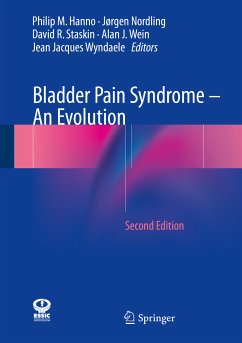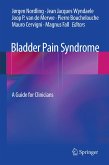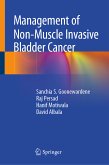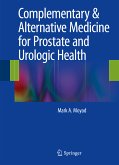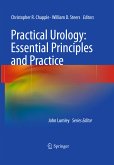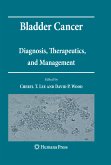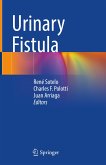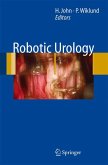Bladder Pain Syndrome – An Evolution (eBook, PDF)
139,09 €
inkl. MwSt.
Sofort per Download lieferbar
Bladder Pain Syndrome – An Evolution (eBook, PDF)
- Format: PDF
- Merkliste
- Auf die Merkliste
- Bewerten Bewerten
- Teilen
- Produkt teilen
- Produkterinnerung
- Produkterinnerung

Bitte loggen Sie sich zunächst in Ihr Kundenkonto ein oder registrieren Sie sich bei
bücher.de, um das eBook-Abo tolino select nutzen zu können.
Hier können Sie sich einloggen
Hier können Sie sich einloggen
Sie sind bereits eingeloggt. Klicken Sie auf 2. tolino select Abo, um fortzufahren.

Bitte loggen Sie sich zunächst in Ihr Kundenkonto ein oder registrieren Sie sich bei bücher.de, um das eBook-Abo tolino select nutzen zu können.
This updated volume provides reflections on the original edition, as well as information on the developments that have occurred within bladder pain syndrome since the publication of the first edition. The epidemiology, etiology, diagnosis, and management of bladder pain syndrome are all covered.
The book aims to give healthcare providers up to date guidelines and management suggestions within a quick-reference text.
This book is relevant to clinicians who focus on bladder pain syndrome, as well as the gynaecologists, general urologists, and primary care providers who see these patients as a part of their practice.…mehr
- Geräte: PC
- ohne Kopierschutz
- eBook Hilfe
- Größe: 3.88MB
- Upload möglich
Andere Kunden interessierten sich auch für
![Bladder Pain Syndrome (eBook, PDF) Bladder Pain Syndrome (eBook, PDF)]() Bladder Pain Syndrome (eBook, PDF)106,99 €
Bladder Pain Syndrome (eBook, PDF)106,99 €![Management of Non-Muscle Invasive Bladder Cancer (eBook, PDF) Management of Non-Muscle Invasive Bladder Cancer (eBook, PDF)]() Sanchia S. GoonewardeneManagement of Non-Muscle Invasive Bladder Cancer (eBook, PDF)53,49 €
Sanchia S. GoonewardeneManagement of Non-Muscle Invasive Bladder Cancer (eBook, PDF)53,49 €![Complementary & Alternative Medicine for Prostate and Urologic Health (eBook, PDF) Complementary & Alternative Medicine for Prostate and Urologic Health (eBook, PDF)]() Mark A. MoyadComplementary & Alternative Medicine for Prostate and Urologic Health (eBook, PDF)106,99 €
Mark A. MoyadComplementary & Alternative Medicine for Prostate and Urologic Health (eBook, PDF)106,99 €![Practical Urology: Essential Principles and Practice (eBook, PDF) Practical Urology: Essential Principles and Practice (eBook, PDF)]() Practical Urology: Essential Principles and Practice (eBook, PDF)287,83 €
Practical Urology: Essential Principles and Practice (eBook, PDF)287,83 €![Bladder Cancer (eBook, PDF) Bladder Cancer (eBook, PDF)]() Bladder Cancer (eBook, PDF)106,99 €
Bladder Cancer (eBook, PDF)106,99 €![Urinary Fistula (eBook, PDF) Urinary Fistula (eBook, PDF)]() Urinary Fistula (eBook, PDF)106,99 €
Urinary Fistula (eBook, PDF)106,99 €![Robotic Urology (eBook, PDF) Robotic Urology (eBook, PDF)]() Robotic Urology (eBook, PDF)110,95 €
Robotic Urology (eBook, PDF)110,95 €-
-
-
This updated volume provides reflections on the original edition, as well as information on the developments that have occurred within bladder pain syndrome since the publication of the first edition. The epidemiology, etiology, diagnosis, and management of bladder pain syndrome are all covered.
The book aims to give healthcare providers up to date guidelines and management suggestions within a quick-reference text.
This book is relevant to clinicians who focus on bladder pain syndrome, as well as the gynaecologists, general urologists, and primary care providers who see these patients as a part of their practice.
The book aims to give healthcare providers up to date guidelines and management suggestions within a quick-reference text.
This book is relevant to clinicians who focus on bladder pain syndrome, as well as the gynaecologists, general urologists, and primary care providers who see these patients as a part of their practice.
Produktdetails
- Produktdetails
- Verlag: Springer International Publishing
- Erscheinungstermin: 30. Oktober 2017
- Englisch
- ISBN-13: 9783319614496
- Artikelnr.: 52936287
- Verlag: Springer International Publishing
- Erscheinungstermin: 30. Oktober 2017
- Englisch
- ISBN-13: 9783319614496
- Artikelnr.: 52936287
Philip M. Hanno, MD, MPH, has a long-standing interest in bladder pain syndrome and female urology, and is Co-Chair of the Medical Advisory Board of the Interstitial Cystitis Association. He is chair of the American Urological Association Guideline Committee on Interstitial Cystitis. He has been Chief of the Division of Urology of the Philadelphia Veterans Administration Medical Center and Professor and Chair of the Department of Urology at Temple University School of Medicine. He was a Medical Officer in the Division of Reproductive and Urologic Drugs in the Food and Drug Administration. He is currently an Emeritus Professor of Urology at the University of Pennsylvania and is Clinical Professor of Urology at Stanford University School of Medicine.
Alan J. Wein, MD, PhD(hon.), FACS Alan J. Wein, MD, PhD(hon.), FACS is the Founders Professor of the Division of Urology at the University of Pennsylvania School of Medicine, Director of theResidency Program in Urology at the University of Pennsylvania. He is a graduate of Princeton University and received his MD from the University of Pennsylvania School of Medicine. He completed training in Surgery and Urology at the University of Pennsylvania including a fellowship at the Harrison Department of Surgical Research. He has been certified and recertified (voluntary) by the American Board of Urology. He was awarded an honorary Ph.D. from the University of Patras, Greece in September 2005. He was made an honorary professor of the Federal State Institute of Urology of Russia in 2010.
David R. Staskin, M.D. Dr. Staskin is an associate professor of urology at Tufts University. He held similar positions at New York Presbyterian Hospital-Cornell and Beth Israel Deaconess Medical Center-Harvard. Dr. Staskin has an international reputation in lower urinary tract pharmacology and devices. He has specific expertise in pharmaceuticals used to treat overactive bladder and stress incontinence. He was member of HHS-AHCPR and a Section Chairperson of ICI-WHO. He has held advisory positions with numerous pharmaceutical and medical device companies.
Alan J. Wein, MD, PhD(hon.), FACS Alan J. Wein, MD, PhD(hon.), FACS is the Founders Professor of the Division of Urology at the University of Pennsylvania School of Medicine, Director of theResidency Program in Urology at the University of Pennsylvania. He is a graduate of Princeton University and received his MD from the University of Pennsylvania School of Medicine. He completed training in Surgery and Urology at the University of Pennsylvania including a fellowship at the Harrison Department of Surgical Research. He has been certified and recertified (voluntary) by the American Board of Urology. He was awarded an honorary Ph.D. from the University of Patras, Greece in September 2005. He was made an honorary professor of the Federal State Institute of Urology of Russia in 2010.
David R. Staskin, M.D. Dr. Staskin is an associate professor of urology at Tufts University. He held similar positions at New York Presbyterian Hospital-Cornell and Beth Israel Deaconess Medical Center-Harvard. Dr. Staskin has an international reputation in lower urinary tract pharmacology and devices. He has specific expertise in pharmaceuticals used to treat overactive bladder and stress incontinence. He was member of HHS-AHCPR and a Section Chairperson of ICI-WHO. He has held advisory positions with numerous pharmaceutical and medical device companies.
Section 1 Introduction.- 1 Interstitial Cystitis: An Introduction to the Problem.- 2 Historical Perspectives.- Section 2 Epidemiology and Etiology.- 3 Epidemiology of Interstitial Cystitis: 1.- 4 Epidemiology of Interstitial Cystitis: 2.- 5 Interstitial Cystitis: Animal Models.- 6 Etiology: Etiologic and Pathogenic Theories in Interstitial Cystitis.- Editorial Comment Etiologic Theories: Deficiency of the Bladder Lining.- Section 3 Diagnosis.- 7 Light Microscopic Findings in Bladders of Patients with Interstitial Cystitis.- 8 Pathology of Interstitial Cystitis.- 9 Mast Cells and Interstitial Cystitis.- 10 Diagnosis of Interstitial Cystitis: A Clinical, Endoscope and Pathologic Approach.- 11 Neurourologic Evaluation in Interstitial Cystitis.- 12 Hydrodistention and Intraoperative Urodynamics.- Editorial Comment The Clinical Evaluation of Patients with Painful Bladder Disease.- Interstitial Cystitis.- Section 4 Management.- 13 Pharmacotherapeutic Goals in Interstitial Cystitis.- 14 Intravesical Therapy of Interstitial Cystitis.- 15 Subcutaneous Heparin in the Treatment of Interstitial Cystitis.- 16 Urine Eosinophil Cationic Protein in Painful Bladder Disease.- 17 Use of Pentosanpolysulfate in the Management of Interstitial Cystitis.- 18 Use of Transcutaneous Electrical Nerve Stimulation in the Management of Chronic Interstitial Cystitis.- 19 Reappraisal of Transurethral Resection in Classic Interstitial Cystitis.- 20 Treatment of Interstitial Cystitis with the Neodymium:YAG Laser.- 21 Partial Bladder Denervation in the Treatment of Interstitial Cystitis in Women.- 22 Surgical Therapy of Interstitial Cystitis.- Editorial Comment Substitution Cystoplasty in the Management of Interstitial Cystitis.- Addendum. Summary of the 1989 AUA Podium Section on Genitourinary Infection: Interstitial Cystitis.
Section 1 Introduction.- 1 Interstitial Cystitis: An Introduction to the Problem.- 2 Historical Perspectives.- Section 2 Epidemiology and Etiology.- 3 Epidemiology of Interstitial Cystitis: 1.- 4 Epidemiology of Interstitial Cystitis: 2.- 5 Interstitial Cystitis: Animal Models.- 6 Etiology: Etiologic and Pathogenic Theories in Interstitial Cystitis.- Editorial Comment Etiologic Theories: Deficiency of the Bladder Lining.- Section 3 Diagnosis.- 7 Light Microscopic Findings in Bladders of Patients with Interstitial Cystitis.- 8 Pathology of Interstitial Cystitis.- 9 Mast Cells and Interstitial Cystitis.- 10 Diagnosis of Interstitial Cystitis: A Clinical, Endoscope and Pathologic Approach.- 11 Neurourologic Evaluation in Interstitial Cystitis.- 12 Hydrodistention and Intraoperative Urodynamics.- Editorial Comment The Clinical Evaluation of Patients with Painful Bladder Disease.- Interstitial Cystitis.- Section 4 Management.- 13 Pharmacotherapeutic Goals in Interstitial Cystitis.- 14 Intravesical Therapy of Interstitial Cystitis.- 15 Subcutaneous Heparin in the Treatment of Interstitial Cystitis.- 16 Urine Eosinophil Cationic Protein in Painful Bladder Disease.- 17 Use of Pentosanpolysulfate in the Management of Interstitial Cystitis.- 18 Use of Transcutaneous Electrical Nerve Stimulation in the Management of Chronic Interstitial Cystitis.- 19 Reappraisal of Transurethral Resection in Classic Interstitial Cystitis.- 20 Treatment of Interstitial Cystitis with the Neodymium:YAG Laser.- 21 Partial Bladder Denervation in the Treatment of Interstitial Cystitis in Women.- 22 Surgical Therapy of Interstitial Cystitis.- Editorial Comment Substitution Cystoplasty in the Management of Interstitial Cystitis.- Addendum. Summary of the 1989 AUA Podium Section on Genitourinary Infection: Interstitial Cystitis.
Section 1 Introduction.- 1 Interstitial Cystitis: An Introduction to the Problem.- 2 Historical Perspectives.- Section 2 Epidemiology and Etiology.- 3 Epidemiology of Interstitial Cystitis: 1.- 4 Epidemiology of Interstitial Cystitis: 2.- 5 Interstitial Cystitis: Animal Models.- 6 Etiology: Etiologic and Pathogenic Theories in Interstitial Cystitis.- Editorial Comment Etiologic Theories: Deficiency of the Bladder Lining.- Section 3 Diagnosis.- 7 Light Microscopic Findings in Bladders of Patients with Interstitial Cystitis.- 8 Pathology of Interstitial Cystitis.- 9 Mast Cells and Interstitial Cystitis.- 10 Diagnosis of Interstitial Cystitis: A Clinical, Endoscope and Pathologic Approach.- 11 Neurourologic Evaluation in Interstitial Cystitis.- 12 Hydrodistention and Intraoperative Urodynamics.- Editorial Comment The Clinical Evaluation of Patients with Painful Bladder Disease.- Interstitial Cystitis.- Section 4 Management.- 13 Pharmacotherapeutic Goals in Interstitial Cystitis.- 14 Intravesical Therapy of Interstitial Cystitis.- 15 Subcutaneous Heparin in the Treatment of Interstitial Cystitis.- 16 Urine Eosinophil Cationic Protein in Painful Bladder Disease.- 17 Use of Pentosanpolysulfate in the Management of Interstitial Cystitis.- 18 Use of Transcutaneous Electrical Nerve Stimulation in the Management of Chronic Interstitial Cystitis.- 19 Reappraisal of Transurethral Resection in Classic Interstitial Cystitis.- 20 Treatment of Interstitial Cystitis with the Neodymium:YAG Laser.- 21 Partial Bladder Denervation in the Treatment of Interstitial Cystitis in Women.- 22 Surgical Therapy of Interstitial Cystitis.- Editorial Comment Substitution Cystoplasty in the Management of Interstitial Cystitis.- Addendum. Summary of the 1989 AUA Podium Section on Genitourinary Infection: Interstitial Cystitis.
Section 1 Introduction.- 1 Interstitial Cystitis: An Introduction to the Problem.- 2 Historical Perspectives.- Section 2 Epidemiology and Etiology.- 3 Epidemiology of Interstitial Cystitis: 1.- 4 Epidemiology of Interstitial Cystitis: 2.- 5 Interstitial Cystitis: Animal Models.- 6 Etiology: Etiologic and Pathogenic Theories in Interstitial Cystitis.- Editorial Comment Etiologic Theories: Deficiency of the Bladder Lining.- Section 3 Diagnosis.- 7 Light Microscopic Findings in Bladders of Patients with Interstitial Cystitis.- 8 Pathology of Interstitial Cystitis.- 9 Mast Cells and Interstitial Cystitis.- 10 Diagnosis of Interstitial Cystitis: A Clinical, Endoscope and Pathologic Approach.- 11 Neurourologic Evaluation in Interstitial Cystitis.- 12 Hydrodistention and Intraoperative Urodynamics.- Editorial Comment The Clinical Evaluation of Patients with Painful Bladder Disease.- Interstitial Cystitis.- Section 4 Management.- 13 Pharmacotherapeutic Goals in Interstitial Cystitis.- 14 Intravesical Therapy of Interstitial Cystitis.- 15 Subcutaneous Heparin in the Treatment of Interstitial Cystitis.- 16 Urine Eosinophil Cationic Protein in Painful Bladder Disease.- 17 Use of Pentosanpolysulfate in the Management of Interstitial Cystitis.- 18 Use of Transcutaneous Electrical Nerve Stimulation in the Management of Chronic Interstitial Cystitis.- 19 Reappraisal of Transurethral Resection in Classic Interstitial Cystitis.- 20 Treatment of Interstitial Cystitis with the Neodymium:YAG Laser.- 21 Partial Bladder Denervation in the Treatment of Interstitial Cystitis in Women.- 22 Surgical Therapy of Interstitial Cystitis.- Editorial Comment Substitution Cystoplasty in the Management of Interstitial Cystitis.- Addendum. Summary of the 1989 AUA Podium Section on Genitourinary Infection: Interstitial Cystitis.
